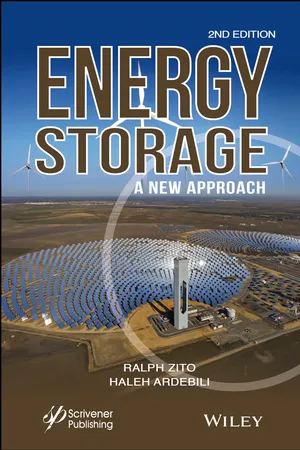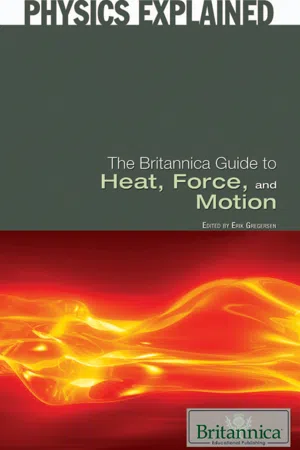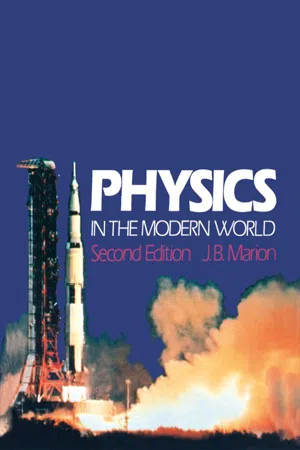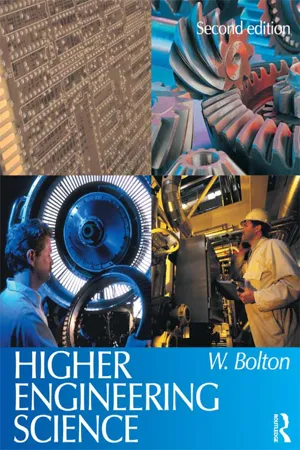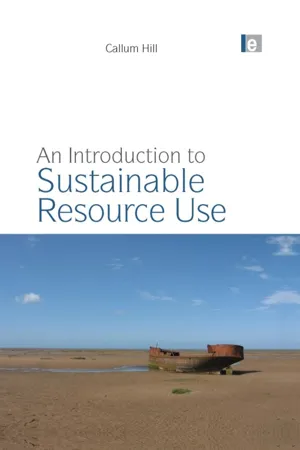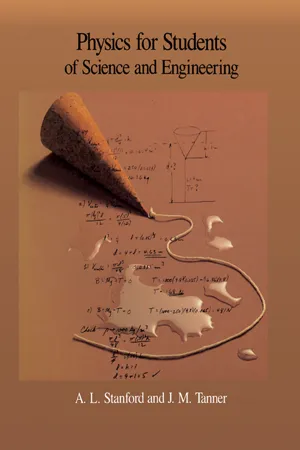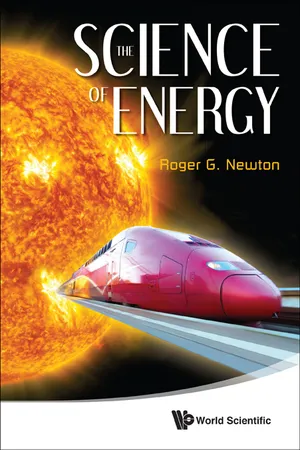Technology & Engineering
Energy in Mechanics
Energy in mechanics refers to the capacity of a physical system to do work. It can exist in various forms such as kinetic energy (energy of motion) and potential energy (stored energy). In mechanical systems, energy is conserved, meaning it can change from one form to another but cannot be created or destroyed.
Written by Perlego with AI-assistance
Related key terms
1 of 5
12 Key excerpts on "Energy in Mechanics"
- eBook - ePub
Energy Storage
A New Approach
- Ralph Zito, Haleh Ardebili(Authors)
- 2019(Publication Date)
- Wiley-Scrivener(Publisher)
The history of the development of physical concepts is not the prime concern here, but some knowledge of their evolution does serve to bring more closely to our attention and scrutiny a better appreciation of terms that we employ daily. Sometimes it is necessary to begin understanding or developing a body of knowledge in order to make certain basic assumptions on an entirely intuitive basis. As scientifically unsatisfying as that may be, it is unavoidable at times. One could draw a weak comparison to plane geometry (Euclid) with regard to its various axioms and the declaration that parallel lines never meet. Even the concept of straight lines is rather intuitive in nature.Perhaps the best definition is that a force is required to change the motion of a body. Many problems arise in finding acceptable definitions for the basic parameters of physical science, namely, the abstract concepts of mass, time, force, and energy. However, we must learn to be satisfied with definitions that leave something to be desired in order to move on toward generating a working body of mechanics that enables us to design and build practical devices that serve our purposes.An interesting definition of energy comes from the Grolier Encyclopedia, which states:Energy can be measured in terms of mechanical work, but because not all forms of energy can be converted into useful work, it is more precise to say that the energy of a system changes by an amount equal to the net work done on the system … In classical physics, energy, like work, is considered a scalar quantity; the units of energy are the same as those of work. These units may be ergs, joules, watt-hours, foot-pounds, or foot-poundals, depending on the system of units being used. In modern science, energy and the three components of linear momentum are thought of as different aspects of a single four-dimensional vector quantity, much as time is considered to be one aspect of the four-dimensional space-time continuum … Energy exists in many different forms. The form that bodies in motion possess is called kinetic energy. Energy may be stored in the form of potential energy, as it is in a compressed spring. Chemical systems possess internal energy, which can be converted by various devices into useful work; for example, a fuel such as gasoline can be burned in an engine to propel a vehicle. Heat energy may be absorbed or released when the internal energy of a system changes while work is done on or by the system. (1993) - eBook - ePub
- Britannica Educational Publishing, Erik Gregersen(Authors)
- 2010(Publication Date)
- Britannica Educational Publishing(Publisher)
work itself acquired a technical meaning with the advent of Newtonian mechanics. For example, a man pushing on a car may feel that he is doing a lot of work, but no work is actually done unless the car moves. The work done is then the product of the force applied by the man multiplied by the distance through which the car moves. If there is no friction and the surface is level, then the car, once set in motion, will continue rolling indefinitely with constant speed. The rolling car has something that a stationary car does not have—it has kinetic energy of motion equal to the work required to achieve that state of motion. The introduction of the concept of energy in this way is of great value in mechanics because, in the absence of friction, energy is never lost from the system, although it can be converted from one form to another. For example, if a coasting car comes to a hill, it will roll some distance up the hill before coming to a temporary stop. At that moment its kinetic energy of motion has been converted into its potential energy of position, which is equal to the work required to lift the car through the same vertical distance. After coming to a stop, the car will then begin rolling back down the hill until it has completely recovered its kinetic energy of motion at the bottom. In the absence of friction, such systems are said to be conservative because at any given moment the total amount of energy (kinetic plus potential) remains equal to the initial work done to set the system in motion.As the science of physics expanded to cover an ever-wider range of phenomena, it became necessary to include additional forms of energy in order to keep the total amount of energy constant for all closed systems (or to account for changes in total energy for open systems). For example, if work is done to accelerate charged particles, then some of the resultant energy will be stored in the form of electromagnetic fields and carried away from the system as radiation. In turn the electromagnetic energy can be picked up by a remote receiver (antenna) and converted back into an equivalent amount of work. With his theory of special relativity, Albert Einstein realized that energy (E ) can also be stored as mass (m ) and converted back into energy, as expressed by his famous equation E = mc 2 , where c - Jonathan Wickert, Kemper Lewis, Jonathan Wickert(Authors)
- 2020(Publication Date)
- Cengage Learning EMEA(Publisher)
Element 6: Thermal and energy systems Copyright 2021 Cengage Learning. All Rights Reserved. May not be copied, scanned, or duplicated, in whole or in part. Due to electronic rights, some third party content may be suppressed from the eBook and/or eChapter(s). Editorial review has deemed that any suppressed content does not materially affect the overall learning experience. Cengage Learning reserves the right to remove additional content at any time if subsequent rights restrictions require it. 7.1 Overview 275 Although you can neither see energy nor hold it in your hand, energy is needed to accelerate an object, stretch it, heat it, and elevate it. The characteristics of energy, the different forms that energy can take, and the methods by which energy can be converted from one form to another lie at the very heart of mechanical engineering. In the internal-combustion engine of Figure 7.2 (see page 276), for instance, diesel fuel is burned to release thermal energy. In turn, the engine converts thermal energy into the rotation of its crankshaft and ultimately into the motion of a vehicle. Machinery that consumes or produces power often involves processes for converting the chemical energy that is stored in a fuel into thermal energy, converting thermal energy into mechanical work and shaft rotation, and moving energy between locations for the purposes of heating or refrigeration. In the first portion of this chapter, we will introduce the physical principles and terminology needed to understand the operation and efficiency of such thermal and energy systems. Later, in Sections 7.6–7.7, we will apply those ideas to two-stroke and four-stroke engines, and electrical power generation.- eBook - ePub
- E. Atlee Jackson(Author)
- 2012(Publication Date)
- Dover Publications(Publisher)
2Energy
1. INTRODUCTION
In the previous chapter we discussed one of the two basic ingredients of statistical mechanics — probability — together with related statistical concepts such as verages, variance, and uncertainty. The second basic ingredient of statistical mechanics is, as its name implies, mechanics. More specifically, it is the concept of energy. Classical thermodynamics, of course, also deals with energy, but only as it arises in macroscopic interactions between systems. Thus it is concerned with the transfer of energy in various macroscopic processes such as changing the volume of a system (and thereby doing p dV work) or heating it with a flame. A fundamental observation of classical thermodynamics is that the work required to go from one equilibrium state to another, in an adiabatic process, is independent of the methods used to perform the work (i.e., the work in an adiabatic process depends only on the end states). This observation, which implies the existence of the state function U (the internal energy), we now interpret as “simply” a macroscopic example of the conservation of energy. Its importance, however, lies in the fact that it is a completely general law (true for all systems) that does not depend on any microscopic picture we may dream up about what is going on inside the system.In statistical mechanics, on the other hand, in which we consider the microscopic nature of these systems, we must deal with microscopic (or mechanical) forms of energy as it appears in the motion and in the interaction between the atoms of the system (the kinetic and potential energy). The energy exchange observed in macroscopic (thermodynamic) processes is, of course, related to the microscopic form of energy — and one of the objectives of statistical mechanics is to make this relationship clear. In the present chapter we shall discuss some of the most important aspects of energy and how it can be described in terms of various component parts. We shall begin with an elementary classical description of the energy of a point particle and then discuss some of the forms of energy that arise because of the interaction between particles. Some models - eBook - ePub
- Jerry Marion(Author)
- 2012(Publication Date)
- Academic Press(Publisher)
7 ENERGY Publisher Summary The total energy of a system remains the same even though energy is changed from one form to another within the system or is exchanged between objects that are part of that system. This chapter focuses on mechanical forms of energy. It discusses thermal energy, electric energy, elastic energy, and mass-energy. Work is always done when an object is moved against some resisting force. It discusses the two forms of energy: (1) kinetic energy and (2) potential energy. The kinetic energy of an object is proportional to its mass and to the square of its velocity. The gravitational potential energy that can be converted into work depends only on the change in height that the object undergoes. The chapter explains rotational kinetic energy. The importance of the energy concept was not fully understood until the middle of the 19th century. By this time it was realized that energy takes many forms—motional energy, chemical energy, heat energy, electromagnetic energy, and so forth. The great unifying principle that places all of the various forms of energy on an equal basis and makes the energy concept of truly universal significance was stated in 1847 by the German physicist Hermann von Helmholtz (1821–1894). Helmholtz’s important contribution was to realize that energy can be converted from one form to another and transferred from one object to another without loss. That is, the total energy of a system remains the same even though energy is changed from one form to another within the system or is exchanged between objects that are part of that system - eBook - ePub
- William Bolton(Author)
- 2012(Publication Date)
- Routledge(Publisher)
5 Energy transfer5.1 IntroductionThis chapter is concerned with the energy transfers that can occur with mechanical systems. Energy can be transferred from one form to another by work being done or by heat transfer. Here we restrict the discussion to transfers involving work. There are many forms that energy can take and in this chapter potential energy, linear and angular kinetic energy and strain energy are discussed and the principles applied to the solution of mechanical system problems.5.1.1 Conservation of energyThere is a basic principle that is used in all discussions of energy and that is that energy is never lost, it is only transformed from one form to another or transferred from one object to another. This is the principle of the conservation of energy. In any process we never increase the total amount of energy, all we do is transform it from one form to another.5.2 WorkThe principle of the conservation of energy is that energy is never created or lost but only converted from one form to another. In all such conversions, the total amount of energy remains constant.Work is said to be done when the energy transfer takes place as a result of a force pushing something through a distance (Figure 5.1 ), the amount of energy transferred W being the product of the force F and the displacement s of the point of application of the force in the direction of the force.Figure 5.1 WorkWith force in newtons and distance in metres, the unit of work is the joule (J) with 1 J being 1 N m.Work done by a constant force W = Fs [1] Consider the work done by a force F when the resulting displacement s is at some angle 0 to the force (Figure 5.2 ). We can look at this in two equivalent ways. We can consider the displacement in the direction of the force F is s cos θ and so the work done is:work done = F × s cos θ [2] Figure 5.2 An oblique forceAlternatively, we can consider the force component acting in the direction of the displacement. The force can be resolved into two components, namely F cos θ in the direction of the displacement and F sin θ at right angles to it. There is no displacement in the direction of the F sin θ component and so it does no work. Hence the work done by the oblique force is solely due to the F cos θ - eBook - PDF
The Silicon Web
Physics for the Internet Age
- Michael G. Raymer(Author)
- 2009(Publication Date)
- CRC Press(Publisher)
These limits are discussed in Chapter 4. To summarize the two general types of energy: Mechanical potential energy is the energy that is stored in objects by virtue of their positions. This stored energy can potentially be released later and cause some work to be done. Examples of potential energy include gravita-tional potential energy gained when you climb (or someone pushes you up) a ramp, chemical energy stored in your muscles, and electrical energy stored in a battery. Kinetic energy is the energy associated with a moving object. An example of kinetic energy is a moving skateboard and rider. 3.6 THE CONSTANCY OF ENERGY This leads us to the most important principle about energy—its constancy or conservation. ◾ ◾ ◾ ◾ ◾ FIGURE 3.21 The behavior of atoms in a gas, liquid, or crystalline solid (a crystal). Gas Liquid Crystalline solid QUICK QUESTION 3.4 Think of other examples in which thermal energy can be used to do work. Mechanics 73 Mechanics Principle (iv) Energy conservation principle: Energy cannot be created or destroyed; it just gets converted between various forms. This means that the total amount of energy in any closed system does not change, but is constant (i.e., conserved). The word closed means that a system cannot exchange energy with other systems. For example, imagine a closed room whose walls are very thick and made of materials that allow no heat, light, radio, or any other form of energy to enter or exit. In this room, there are various stores of supplies, such as firewood, oil, and food, and there are appa-ratuses such as steam engines, water wheels, water pumps, and electrical generators. A person in this room could perform many tasks involving energy—move objects, boil water, drive steam-powered generators, power light bulbs, etc. But, all of these tasks involve only the conversion of energy from one form to another—not the creation or destruction of energy. - eBook - ePub
Engineering Thermodynamics
Fundamental and Advanced Topics
- Kavati Venkateswarlu(Author)
- 2020(Publication Date)
- CRC Press(Publisher)
Chapter 6 .Energy exists in several forms such as mechanical, thermal, electrical, chemical, and nuclear energy. Mass is also regarded as a form of energy. Energy transfer either into or out of a closed system takes place by two mechanisms: heat transfer and work transfer, and it involves no mass crossing its boundary. For open systems, it is by mass flow also. An energy transfer either into or out of a closed system is heat, if it is as a result of a temperature difference and it is work, if it is as a result of a force acting through a distance. Figure 3.1 shows how an open system interacts with its surroundings.FIGURE 3.1 An open system interacting with its surroundings.3.2 Different Forms of Stored Energy
The word energy was first used by Thomas Young in 1807, whereas its use in thermodynamics was suggested by Lord Kelvin in 1852. The total of all the energies—mechanical, thermal, electrical, chemical, and nuclear energies—is called the total energy of a system, indicated by E. The total energy on a unit mass basis is indicated ase =(3.1)E mThe total energy of a system can be divided into macroscopic and microscopic forms. The macroscopic form of energy is the energy a system possesses as a whole with respect to some reference point. Kinetic and potential energies are of the macroscopic form. The microscopic form, on the other hand, is concerned with the molecular structure of a system and molecular activity. The internal energy is the sum of all the microscopic forms of energy, which is indicated by U. - eBook - ePub
- Callum Hill(Author)
- 2012(Publication Date)
- Routledge(Publisher)
Energy is used to move things, to drive machinery, to provide heat and electricity, and to stay alive. Without energy there would be no change and time would not exist. But what exactly is it? For many years energy was seen as a mysterious force that acted upon matter and somehow gave it ‘life’ and it was given a name that reflected this idea, ‘vis viva’. Even now, much misunderstanding exists; it is common to see the words ‘energy’ and ‘power’ used interchangeably although they mean different things, or references to energy ‘consumption’, whereas energy is always conserved. There is no doubt that something is being consumed when we use energy and we shall examine later in this chapter what this something is.To quote the Nobel Prize-winning physicist Richard Feynman, ‘It is important to realize that in physics today, we have no knowledge of what energy is.’ But if we are not exactly sure what energy is, we certainly know what it does, we can describe how it behaves, what properties it exhibits and how it interacts with matter.A standard textbook definition of energy is ‘energy represents the capacity to do work’. Although true, this is not necessarily very helpful when trying to get a mental picture of energy. Perhaps a better definition is the rather dry, but accurate, state- ment ‘energy has the ability to bring about transformation in a system’. The system represents the particular part of the universe which is the subject of study, and this might be an engine, a power station, a tree or a recycling process (we’ll look at this a little later). Energy transformation causes change, which is why energy and time are interwoven.Let us return for a moment to the narrower definition of energy as the ‘capacity to do work’. Work is what happens when something moves (work = force × distance). Work involves the organized motion of assemblies of atoms or molecules.A bicycle is clearly an organized assembly of molecules and atoms, and by pedal- ling this assembly, motion will result. The bicycle has been given kinetic energy by the contraction and extension of leg muscles whose chemical energy is derived ulti- mately from sunlight. Sunlight is converted into the movement of a bicycle through the mechanics of legs (plus a few other conversions along the way). - Available until 16 Feb |Learn more
Classical Mechanics
A Computational Approach with Examples Using Mathematica and Python
- Christopher W. Kulp, Vasilis Pagonis(Authors)
- 2020(Publication Date)
- CRC Press(Publisher)
5.1.12 ), we see that solving problems using conservation of energy requires only that we compare one state of the system to another. For example, suppose we drop a rock starting at rest from a height of 5 m above the ground and we want to know the kinetic energy of the rock after it fell 2 m. All we need is to know is the initial kinetic energy (which is zero) and the initial and final potential energies in order to obtain the final kinetic energy (and thus the speed). We don’t need information about the state of the system during the actual fall!Equation (5.1.12 ) also tells us that if the potential energy of the system decreases, its kinetic energy must increase and vice versa, in order to maintain the equality of both sides of the equation. The ability to interpret the meanings behind equations such as (5.1.8 ) and (5.1.12 ) is an important skill for physicists.Example 5.1: Simple harmonic motion and conservation of energyConsider a mass m on a spring with spring constant k performing simple harmonic motion with amplitude A. The force is given by Hooke’s law F = −kx where x is the displacement from equilibrium.(a) Find the total mechanical energy in terms of A.(b) Find an expression for the turning points in the motion, the points at which the velocity v of the particle is zero and the mass turns around, as a function of the total mechanical energy E and spring constant k.Solution:(a) We will solve this problem using energy conservation. In order to use energy conservation, we need to first find the potential energy associated with the spring. The potential energy associated with the force of the spring is called the elastic potential energy - eBook - ePub
- A. L. Stanford, J. M. Tanner(Authors)
- 2014(Publication Date)
- Academic Press(Publisher)
5Work, Power, and Energy
Publisher Summary
This chapter discusses physical quantities and concepts necessary for the understanding of energy and its associated conservation principle. In the nonscientific world, work is often thought of in terms of some physical or mental effort. In physics, however, the term work is defined precisely. Doing work requires the use of force, and work on a body does not take place without displacement of that body. The rate at which work is done is often of interest in practical applications. Power is the measure of the rate at which work is being done. It is sometimes convenient to express power in terms of a constant force acting on an object moving at a constant velocity. A unit commonly used for measuring electrical power is the kilowatt . A particle or a system of particles that has the capacity to do work is said to possess energy, a physical quantity associated with the particle or system that may take many forms. In the technical sense, however, a system that has the ability to do work is said to have energy. Energy is a scalar quantity that is usually expressed in terms of the same units as those of work.This chapter introduces one of the most important and perhaps the most far-reaching of all principles in the sciences—the conservation of energy. A conservation principle is a rule or a natural law that specifies that the value of a physical quantity does not change during the course of a physical process but remains constant. The quantity that does not change is said to be conserved. The simplicity of conservation principles makes them concise expressions of natural law and powerful tools of scientific analysis. Conservation of energy is only one of a number of conservation principles that students of science or engineering will encounter. The significance and the usefulness of these principles should become apparent to the student as they are used to analyze and interpret physical phenomena. - eBook - PDF
- Roger G Newton(Author)
- 2012(Publication Date)
- World Scientific(Publisher)
Energy conservation in classical mechanics was not an accidental byproduct of Newton’s equations; it was a basic consequence of their structure. But wait! Is energy really conserved? If you look closely at the motion of a pendulum, you notice that on its second swing it does not rise quite to the same height where it started: the bob has lost some of its potential energy. Indeed, any real pendulum will eventually come to rest, and all its kinetic and potential energies have vanished. Friction prevents mechanical systems from conserving their energy. 5 In the eighteenth century this presented a mystery, 10 Work from Heat and The Basic Laws which was solved in the nineteenth century when the nature of heat became understood. Heat and the Conservation Law What solved the apparent mystery of lost energy in mechanical systems was the recognition that friction produced heat, and heat was also a form of energy. The reason why this fact was not recognized earlier was that heat had for a long time been thought of as a fluid, called caloric, that permeated all matter and had the intrinsic property of flowing from hot to cold regions. However, when friction was demonstrated to be able to melt ice and make iron objects such as gun barrels red hot, the caloric theory was gradually replaced by the kinetic theory of heat: heat was recognized to be nothing but random motion of the molecules making up matter. Heat therefore made up another form of energy. In a certain sense, however, it is an epiphenomenon. From the submicroscopic point of view, there is no heat, only molecular motion. However, from the macroscopic viewpoint, from which we normally see all matter and with which thermodynamics deals, there is a clear distinction between ordered motion of the whole (mechanical energy) and disordered motion of molecular costituents (heat).
Index pages curate the most relevant extracts from our library of academic textbooks. They’ve been created using an in-house natural language model (NLM), each adding context and meaning to key research topics.
